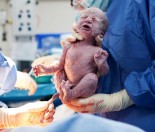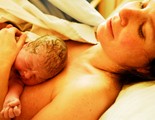The first few days after a Caesarean section can be difficult and tiring. This article covers what to expect in the post natal ward after a Caesarean section.
The caesarean section rate in New Zealand continues to rise.
In 1984 the caesarean section rate in New Zealand was just 9.6%. By 2014 this had increased to 25% of all births in that year. And the actual figure could be even higher. The caesarean section rate at Auckland hospital was almost 35%.
If you haven’t already, you should read the First 24 hours after a caesarean before this article. This will give you a better picture of the whole healing process.
Recovery after the operation
Caesarean sections can be planned (elective) or carried out as an emergency during labour. Either way the operation and the recovery procedure are the same – although planned Caesareans statistically have a lower risk of infection and complications, possibly because they are carried out in a less hurried manner and during daylight hours.
Whatever the reason for your operation, you have had major abdominal surgery and therefore the recovery process will be slow and is dependent upon your health and several factors which can improve or hinder recovery after an operation.
Factors which speed up recovery following a Caesarean
- A healthy balanced diet of carbohydrate, protein, vitamins and minerals
- Plenty of fluids, especially water
- Rest and minimal lifting
- Cleanliness of the wound
- Previous good health
- Gentle exercise
Factors which can slow down recovery in the first few days
- A poor diet, with a lack of fruit and vegetables
- Dehydration
- Over-doing it in the first few weeks, putting unnecessary strain on the wound
- Dirt getting into the wound, increasing the risk of infection
- Previous medical problems, such as diabetes or circulatory problems
- Lack of exercise in pregnancy
What to expect in the first few days after a Caesarean
The day of the birth, the day you have your Caesarean section, may be referred to as ‘Day 0 or Day 1’. What to expect on this day is covered in our article First 24 Hours after Caesarean. Most women stay in hospital with their baby for at least 3 days after the Caesarean birth, giving them time to rest and receive any midwifery and medical help they require.
The day following the operation you will be encouraged to be up and about as much as possible. Bed rest can cause the following complications –
- A blood clot in the leg, caused by sluggish blood flow back to the heart. This is known as a Deep Vein Thrombosis or DVT and is well known as a complication of long haul flights too. Leg exercises such as flexing your feet and writing an imaginary alphabet with your toes improves your circulation when you are stationary.
- Chest infections can also result, and if you are bed bound you will be encouraged to do deep breathing exercises.
- Pressure sores can also occur due to poor circulation to the areas of the body that has weight on it for a long period of time. This is particularly a risk if you are overweight.
Although procedures will vary from region to region and from hospital to hospital the following would be true of most hospitals –
A urinary catheter is a thin plastic tube which is inserted into your bladder through the urethra next to your vaginal opening. This is attached to a bag which collects your urine. This will usually be removed the morning after your operation and then you will be assisted to the toilet the next time you pass urine. As the catheter tube keeps your urethra unnaturally straight, the sooner this is removed the better. Most women then pass urine without a problem and the midwifery staff will check that you are not having a problem.
Vaginal blood loss will be initially moderately heavy after a Caesarean section. Maternity pads or sanitary towels for heavy loss will be suitable for the first few days in hospital. Large, cotton or disposable knickers that go well above the wound will be most comfortable.
The majority of women will get up for a shower also, with assistance. The abdominal wound will be covered by a dry dressing which can be removed prior to the shower and any stitches or clips will be left in place fro a few more days.
Usually women have started drinking and taking a light diet by the evening of the operation so by the next day should be taking their normal diet. Any drips and infusions will usually have stopped by now – although some women do still require a pain relief infusion. Mainly the pain is controlled by oral medication and it is imperative that women receive enough pain relief so that they move around freely to avoid the above complications. If women are confined to bed a midwife or physiotherapist will show them some simple exercises to do in bed. If you need to cough or sneeze, supporting your abdomen by ‘hugging’ a pillow will help to support your abdominal muscles.
Your midwife will still observe you closely at this stage, to ensure there are no signs of infection or bleeding in the wound.
If you have any previous medical or pregnancy related problems, such as high blood pressure, your doctor will reassess you on the ward to ensure that your medications, if any, are correct and that you are having a complication-free recovery.
Breastfeeding after a Caesarean
For full information on Breastfeeding, please visit our breastfeeding articles in the Babies section.
After a Caesarean the only thing you should lift in the first week is your own newborn baby. If you feel unsure about how to do this safely ask the staff to show you how to lift your baby without putting stress on the wound.
By the day after your operation you will be able to sit up or lie in bed, or sit in a chair to breastfeed, so this will make it easier and more comfortable to feed your baby. It’s important as always to feed your baby whenever the baby is rooting and showing an interest in feeding.
Caesarean section itself should not delay your milk ‘coming in’ on day 3, but if there was a lot of stress around the birth that could hinder lactation. By frequent feeding, which most babies will want to do the day after the birth, you will become practised and more confident, ready for your milk to come in over the next day or two. Meanwhile you are feeding your baby colostrum. This is high in calories and natural immunity, so is vital to your baby at this stage.
Mothers who have had a Caesarean birth may need more help with latching on the baby if they are still in discomfort or pain. Do ensure that you have pain relief prior to a feed. The midwives will only administer pain relief which is safe for breastfeeding.
Leaving hospital with your baby after a Caesarean
After around 3 days, most women are recovering amazingly well and do feel ready to go home with their baby. Your midwife or Lead maternity Carer will visit you at home for up to 6 weeks, coming in frequently to begin with, then less so as you recover and become more confident.
Over the last couple of days you will have needed less pain relief (you will be given some to take home, if required), you will be up and about, eating normally and moving more easily. Your wound will not require a dressing (loose high knickers will be great) and if you still have stitches or clips over the wound which need to be removed, your midwife can do that at home. Some stitches are disolvable, so if the wound is clean and dry there will be nothing else required but time, to allow it to heal. The staff will also check that you are not having a problem passing urine, or moving your bowels.
It is important to be sure that you feel confident feeding your baby before you leave the safety net of the hospital, particularly if your breasts feel full and it is difficult to latch baby on well. Be sure not to rush home and put yourself under undue stress, no matter how much you are looking forward to being back at home in your own bed! Some women stay in hospital for 5-7 days after a Caesarean, particularly if they have had complications, so keep an open mind.
Tips for the journey home
- If possible ask your husband/partner (or a friend or relative) to pop in and check your house is tidy and dinner is already prepared for you
- Make sure baby has had a good feed before you leave the hospital – arriving home with a crying, hungry baby will not be a great start
- Wrap baby warmly if it is winter time, especially remembering a hat
- Don’t forget the car seat (practise strapping this in the car before your baby is born).
Useful articles on recovery after a Caesarean
Now that you know more about the first few days after a caesarean section, you might want to check out At home after a caesarean for more information on healing. You can also read more about the benefits of Breastfeeding. Or check out 100s more great articles in our Babies section.





